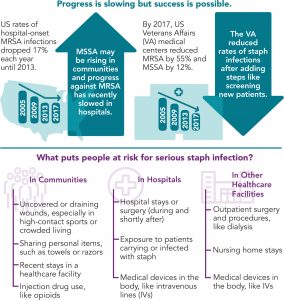
New report shows significant national progress is slowing, causing concern
Staph infections are still a threat. Staph is found on the skin of humans and does not always cause infections. If staph gets into the blood stream, serious infections can develop that may lead to sepsis.
CDC’s Vital Signs report that more than 119,000 people suffered from bloodstream Staphylococcus aureus (staph) infections in the United States in 2017; and nearly 20,000 died. The report underscores that both types of S. aureus (methicillin-resistant or MRSA, and methicillin-susceptible or MSSA) can be deadly.
Recent findings show that hospital infection control efforts successfully reduced rates of serious staph infections in the U.S. (about 17% each year; 2005-2012). Recent data, however, show that this success is slowing and the rise in staph infections in the community may be linked to the opioid crisis.
The risk for serious staph infection is greatest when people:
- Stay in healthcare facilities or have surgery
- Have medical devices placed in their body
- Inject drugs such as opioids
- Come into close contact with someone who has staph
Healthcare providers and administrators can protect patients:
- Make staph prevention a priority
- Follow CDC recommendations, including Contact Precautions, to prevent spread of staph
- Consider additional interventions, like screening or decolonizing high-risk patients, if not meeting infection reduction goals
- Treat infections appropriately and rapidly if they do occur
- Educate patients about ways to avoid infection and spread, and about early signs of sepsis
Learn more:
- CDC Contact Precautions Recommendations
- Strategies to Prevent Hospital-onset Staphylococcus aureus Bloodstream Infections in Acute Care Facilities.
- New data on USA100 and USA300 strains
- CDC: What is sepsis?
- Have more questions? Tune in to CDC’s Facebook page for a Facebook Live on March 26 with experts talking about how to protect yourself, your patients and loved one from staph.
